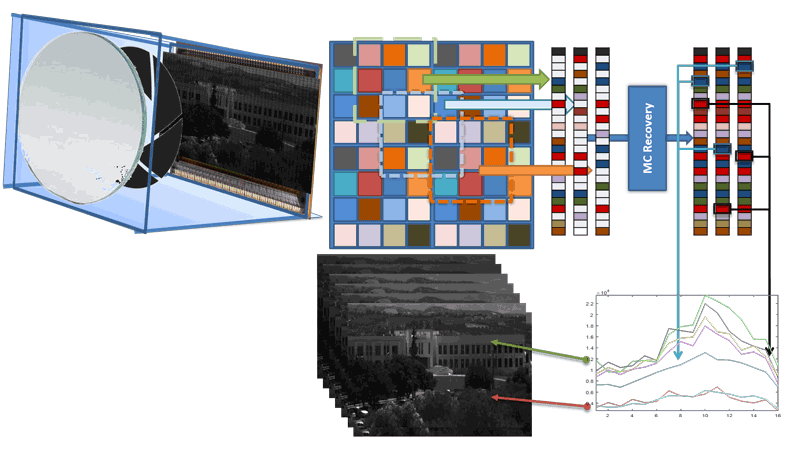by Grigorios Tsagkatakis and Panagiotis Tsakalides
Within the EU funded PHySIS project (Sparse Signal Processing Technologies for Hyper Spectral Systems), we are developing a novel approach to achieve high speed and high resolution spectral imaging by leveraging cutting edge signal processing paradigms.
Spectral imaging aims at acquiring tens to hundreds of spectral bands - many more than the three bands acquired by colour imaging. From an application perspective, analysis of spectral data acquired by Earth observing satellites has greatly aided our understanding of global environmental and ecological phenomena, while its applications in manufacturing, food quality control, and biomedical imaging are also gaining momentum.
A fundamental challenge that spectral imaging systems have to address is the collection of the four dimensional datacube - two spatial, one spectral, and one temporal - using a single, a 1D array, or 2D array detectors. This discrepancy between the requested and the available dimensionality of detectors has sparked different philosophies in spectral imaging system design. Nevertheless, a shortcoming shared by traditional methods pertains to the scanning requirements for constructing the complete high dimensional datacube, resulting in slow acquisition rates, and motion artefacts.
Within the EU funded PHySIS project [L1], a consortium consisting of FORTH-ICS as the leader, the Cosmostat Lab of CEA, IMEC, NOA, and Planetek Italia, considers a novel spectral imaging architecture which can provide extremely high acquisition rates, eliminating the issues associated with scanning. The IMEC snapshot spectral camera relies on the deposition of a Fabry-Perot spectral filter on top of each individual detector element, thus associating each pixel with a single spectral band, achieving a novel operation point in spatial, spectral and temporal resolution trade-off curves. As a result, the effective spatial resolution is dramatically reduced as the required spectral resolution increases.
To address this limitation, in PHySIS we invoke the paradigm of computational imaging, (CI) which involves the coupled design of optical architectures and algorithmic tools for unprecedented imaging capabilities. A decisive factor that allows CI to demonstrate its potential is the recent mathematical and algorithm framework of compressed sensing [1], which has led to designs with a profound impact in diverse domains from medicine, to astronomy and radar. While various compressed sensing spectral imaging systems have also been recently proposed, these architectures involve multiplexing the measurements before acquisition, thus necessitating additional optical components like microlens arrays and dispersive elements in order to achieve ‘incoherent’ sampling.
To recover the full resolution spectral cube, we consider matrix completion (MC) [2], an algorithmic framework which has recently emerged on the heels of compressed sensing and addresses the recovery of matrix-structured data from an incomplete and possibly noisy set of measurements. Provided sufficiently randomly selected measurements are available, recovery of a low-rank matrix is possible by solving an efficient nuclear norm minimisation problem. The MC framework can allow the recovery of full resolution spectral cubes from measurements obtained by snapshot spectral imagers [3] (cf. 1).

Figure 1:Illustration of the MC recovery of snapshot spectral imaging.
In addition to the problem of snapshot spectral image recovery, the MC framework has also been considered for other CI problems like high dynamic range image acquisition, synthetic aperture radar, and ultrasound imaging. The straightforward random sampling and the universality of the method with respect to the data, justify the potential for MC in CI. At the same time, the extension of this framework to high dimensional data structures like tensors, leading to formulations like tensor completion is also expected to have a significant influence in the design of paradigm shifting CI architectures.
Link:
[L1] http://www.physis-project.eu
References:
[1] D. L. Donoho: “Compressed sensing”, IEEE Transactions on information theory 52.4: 1289-1306, 2006.
[2] E. J. Candès, B. Recht: “Exact matrix completion via convex optimization”, Foundations of Comp. mathematics 9.6: 717-772, 2009.
[3] G. Tsagkatakis, et al.: “Non-negative Matrix Completion for the Enhancement of Snapshot Mosaic Multispectral Imagery”, IS&T Int. Symp. on Electronic Imaging, Image Sensors and Imaging Systems, San Francisco, CA, 2016.
Please contact:
Grigorios Tsagkatakis and Panagiotis Tsakalides, FORTH-ICS, Greece
http://www.spl.edu.gr











